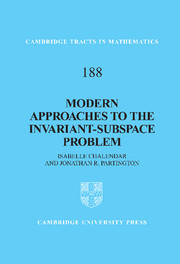Book contents
- Frontmatter
- Contents
- Preface
- 1 Background
- 2 The operator-valued Poisson kernel and its applications
- 3 Properties (An,m) and factorization of integrable functions
- 4 Polynomially bounded operators with rich spectrum
- 5 Beurling algebras
- 6 Applications of a fixed-point theorem
- 7 Minimal vectors
- 8 Universal operators
- 9 Moment sequences and binomial sums
- 10 Positive and strictly-singular operators
- References
- Index
Preface
Published online by Cambridge University Press: 07 October 2011
- Frontmatter
- Contents
- Preface
- 1 Background
- 2 The operator-valued Poisson kernel and its applications
- 3 Properties (An,m) and factorization of integrable functions
- 4 Polynomially bounded operators with rich spectrum
- 5 Beurling algebras
- 6 Applications of a fixed-point theorem
- 7 Minimal vectors
- 8 Universal operators
- 9 Moment sequences and binomial sums
- 10 Positive and strictly-singular operators
- References
- Index
Summary
There is an outstanding problem in operator theory, the so-called ‘invariantsubspace problem’, which has been open for more than half a century. There have been significant achievements on occasion, sometimes after an interval of more than a decade, but its solution seems nowhere in sight. The invariantsubspace problem for a complex Banach space χ of dimension > 1 concerns whether every bounded linear operator T : χ → χ has a non-trivial closed T-invariant subspace (a closed linear subspace M of χ which is different from both {0} and χ such that T(M) ⊂ M). Throughout this book, when we talk about invariant subspaces, we always assume that they are closed and non-trivial.
For the most important case of Hilbert spaces ℋ the problem is still open, although Enflo [95, 96] and Read [168, 169] showed that the invariantsubspace problem is false for some Banach spaces.
The general case of the invariant-subspace problem is still open, but there are many positive results in this direction. For example, every finite-rank operator on a non-zero complex space has an eigenvector, and this generates a one-dimensional invariant subspace. Thus the conjecture is easily resolved in the case that the underlying Hilbert space is finite-dimensional. Moreover, every non-zero vector is contained in a smallest invariant subspace, the cyclic subspace it generates, which is separable. Thus the question is easily answered for non-separable Hilbert spaces.
- Type
- Chapter
- Information
- Modern Approaches to the Invariant-Subspace Problem , pp. ix - xiiPublisher: Cambridge University PressPrint publication year: 2011

